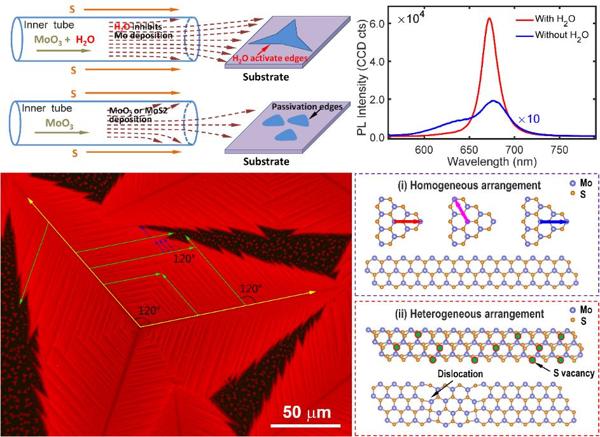Monolayered molybdenum disulfide (MoS2) has attracted much attention from researchers because of its direct bandgap electronic structure and unique excitonic properties. In particular, MoS2 in its monolayer form has broad applications in catalysis, nanoelectronics and optoelectronics and so forth. The performances of these devices are determined by the physical properties of MoS2 layered materials, which are, fundamentally, determined by the material characteristics, such as morphology and quality. So, it is essential to synthesize high-quality MoS2 films with the desired morphology and physical properties. So far, numerous fabrication methods have been developed to obtain monolayer or few-layer MoS2 such as exfoliation,physical vapor deposition, hydrothermal synthesis and so on.
Among these synthetic methods, chemical vapor deposition (CVD) is widely regarded as the most practical route towards large area uniform monolayers because of its low cost, high scalability and operation simplicity, by which versatile flake shapes such as triangles, stars, hexagons, and dendrite, etc., have been successfully synthesized. However, it is still challenging to grow large-scale, continuous, and high quality MoS2 films due to the weak reproducibility and random MoS2 grains.
In addition, triangle-shaped MoS2 monolayer domains are believed to be high-quality crystals, which are easy to identify and use. However, it is hard to control the real-time Mo/S ratio on the growth substrate surface because the Mo/S ratio may vary along the gas flow direction. Moreover, chemical contamination is inevitably introduced into the growth system because the precursors contain other elements in addition to sulfur and molybdenum. Recently, dendrite-type self-assembly monolayers MoS2, one of the most complicated cases, have been extensively studied on versatile substrates by CVD. However, large area and uniform dendrite-type monolayer MoS2 with extreme large area and strong fluorescence are still challenging. In addition, the related growth mechanisms are not that clear understood as homogeneous growth cases thus far.
Cooperation between the Photothermal Manipulation Research Center and the Academician Wang Guanghou Group of the School of Physics, Nanjing University, demonstrated that the uniform fractal growth of centimeter sized dendrite-type monolayers MoS2 with rationally-designed spatially dependent chemical concentrations by introducing trace amount of water sources (CuSO4·5H2O) and temperature control, which exhibit pronounced photoluminescence (PL) enhancement of orders of magnitude with respect to the conventional triangular monolayers MoS2. Relevant results have been published in Chinese Optics Letters, Vol. 20, No. 1, 2022 (Huanhuan Su, Lin Zhou, et al. Chemically engineered dendrite growth of uniform monolayers MoS2 for enhanced photoluminescence [Invited]).
The fast and large area dendrite growth as well as pronounced PL enhancement are unraveled by microscopic fluorescence spectroscopy (MFS), which can be regarded as off-stoichiometric-ratio growth due to aqueous gas assisted generation of high density of S-poor sites in diffusion-limited growth configuration. Figure 1 shown that the growth mechanism of dendritic monolayer MoS2 induced by trace water by CVD and fluorescence regulation map.

Fig. 1 Analysis of the CVD-grown uniform dendritic monolayer MoS2 morphology and fluorescence spectrum
To unravel the physical mechanism of the dendrite-type growth of monolayer MoS2, a theoretical model is proposed to resemble the heterogeneous dendrite growth. In the simulation model, we suggest that there are three types of basic building blocks for the self-assembly of large area monolayers under the self-limiting growth condition, the inter-angle of which are 120° either in clockwise or anti-clockwise direction. The PL emission should be weak since the recombination centers of perfect lattices are rather limited, which forms the framework or dendrite-like branches. Now considering the roles of the trace amount of water sources. Due to the water-assisted chemical corrosions, the S atoms located in the defect-rich area, for example the grain edges as well adjacent regions between different sub-branches, tend to be severely removed, leading to high density of S-poor sites or highly activate recombination centers in heterogeneous arrangement.
Thus, the PL emission of these areas can be significantly enhanced. The interlaced heterogeneous (S-poor) and homogeneous (S-rich) areas finally result in the branch-like fluorescence profile. In addition, in accompany with increased S atoms being knocked out from the monolayers, S-poor areas become even more heterogeneous and thus more chemically active. Such positive feedback can further accelerate the growth velocity and generate considerable large monolayer flakes, ideal for scalable fabrication of ultra-bright large-area monolayers MoS2. The results can provide a highly scalable fabrication strategy for ultra-bright uniform monolayers TMDs.


